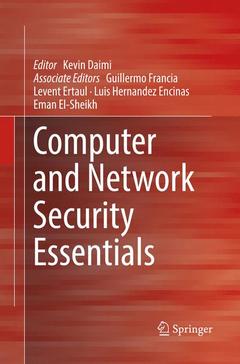Computer and Network Security Essentials, Softcover reprint of the original 1st ed. 2018
Coordonnateur : Daimi Kevin

Introduces various techniques, methods, and approaches adopted by experts in computer and network security
Provides a detailed explanation of security concepts, reinforced by practical examples
Provides a road map for emerging and future trends in security research and development and how they might affect the field
Includes supplementary material: sn.pub/extras
Date de parution : 05-2018
Ouvrage de 618 p.
15.5x23.5 cm
Disponible chez l'éditeur (délai d'approvisionnement : 15 jours).
Prix indicatif 137,14 €
Ajouter au panierDate de parution : 08-2017
Ouvrage de 618 p.
15.5x23.5 cm
Disponible chez l'éditeur (délai d'approvisionnement : 15 jours).
Prix indicatif 189,89 €
Ajouter au panier


